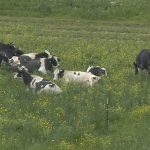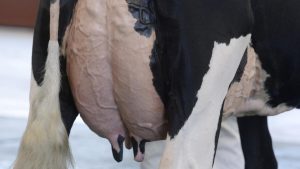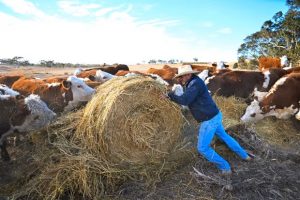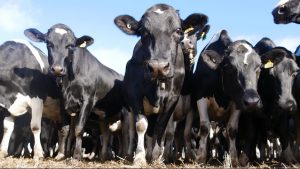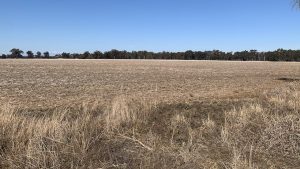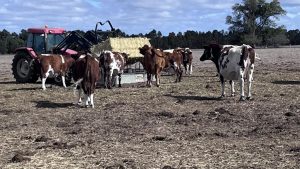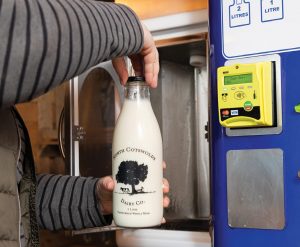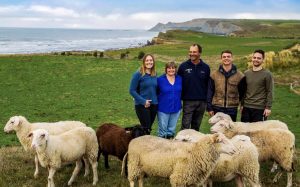
The record-breaking drought crippling South Australia, Victoria and parts of New South Wales and Tasmania feels different to those farmers have endured before.
For many farming families, the slow creep of failed seasons, sold-out hay and rising costs continues to cascade into a deeper crisis day by day.
It will stay that way until there’s decent rain and the ground is warm enough to grow feed — which could take weeks, if not months.
The Victorian Country Hour has been touring the state’s drought-affected regions and it’s clear to me that Australian farmers are changing the way they deal with extreme pressure.
Angus Verley and Warwick Long at Elise Kealy’s farm in Charam in western Victoria. (Supplied: Angela Kealy)
Mental health top of mind
Tim Healy is a tough-looking stock agent with an eye for a good animal.
Speaking from a bone-dry corner of the south-west of the state, his voice broke as he stressed the importance of mental health.
“We should be asking people, ‘Are they OK?'” he said.
“The mental strain and the mental pressure they’re going through is horrendous.”
Tim Healy says talking about mental health during the drought is important. (ABC Rural: Jane McNaughton)
Everywhere we travelled in regional Victoria, mental health was mentioned as a top priority.
A dairy farmer told me that almost every vet, salesperson, farm consultant or friend who came to his farm was asking how he was going and if he was OK.
This feels like a change. He thinks so, too.
Mick and Jane Fitzgibbon started the Let’s Talk Foundation after the loss of 16 people in their community to suicide, including their son Sam.
“Seventy-five per cent of farmers do not reach out,” Ms Fitzgibbon said.
So what can they do to share the load?
“Just ringing up and chatting to your neighbour or go and visit your neighbour, and learn the skills about looking after your health,” Mr Fitzgibbon said.
Farmers see the Aurora Australis during a gathering to support each other. (Supplied: Let’s Talk Australia)
Later that night, 25 farmers did just that, coming together on a south-west Victorian farm to support each other.
There is more to do, but mental health is a bigger part of dealing with this drought than I have ever seen before.
Modern farmers doing things better
For more than a century, drought coverage in Australia was filled with images of dead and dying farm animals on cracked, dry paddocks.
This time, the barren paddocks are there but the animals are better fed.
There’s no feed growing, but farmers are ensuring their animals are fed. (ABC Rural: Warwick Long)
Modern farmers know what their livestock need.
They use feed tests to work out energy and protein levels and they travel long distances to get the supplies they need.
“I feel blessed to be in this situation we’re in with so much more knowledge,” Edenhope farmer Wayne Caldow said.
He remembered his first drought.
“We never had the knowledge of what a sheep required, especially a twin-lambing ewe,” he said.
Wayne Caldow says he has more knowledge of how to deal with drought now. (ABC Rural: Warwick Long)
Naringal dairy farmer Renata Cumming lived in northern Victoria during the Millennium Drought.
“What I saw with dairy farms up there [was] the ones that bounced back were the ones that carried stock through and didn’t cull drastically,” she said.
Farming is a constant quest for improvement and, while previous generations did the best they could, it is clear knowledge and technology are helping inform better decision-making.
But knowledge comes at a price and keeping animals alive has become costly for those farming through the drought.
Renata Cumming and Matt Grant use hay and cotton feed for their cows. (ABC Rural: Jane McNaughton)
Prepared for climate change
South-west Victoria has some of the most expensive farmland in Australia, in part because it has reliable rainfall and can adapt to climate change.
Renata Cumming says she will keep learning how to best farm in drought. (ABC Rural: Jane McNaughton)
Dairy farmer Matt Grant said he felt prepared for this drought — the worst in recent memory.
He stockpiled 18 months of hay and 12 months of grain to get by.
“Early on we recognised we needed to be organised to get through,” he said.
That supply is almost exhausted, forcing him to buy alternative options such as cotton and almond feed.
Farmers are trucking in feed for their animals. (ABC Rural: Jane McNaughton)
Many of the farmers in this area thought they were better prepared for climate change, but they’re learning they might not have done enough.
So, like generations before them, they’ll need to keep learning and improving.
If you look hard enough, you will find examples contrary to what I have seen on my trip.
But what is clear is that the farmers I have met during this terrible drought are adapting to the challenges they’re facing.
You can now read the most important #news on #eDairyNews #Whatsapp channels!!!
🇺🇸 eDairy News INGLÊS: https://whatsapp.com/channel/0029VaKsjzGDTkJyIN6hcP1K


